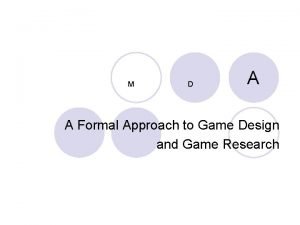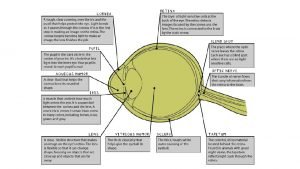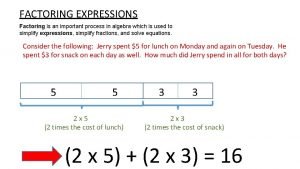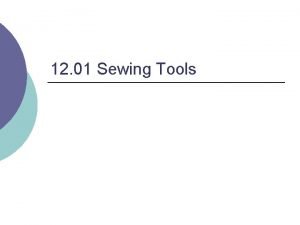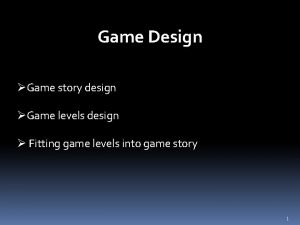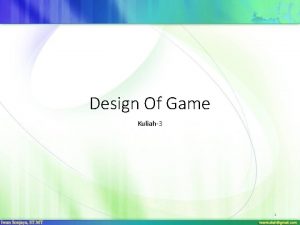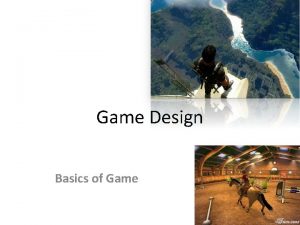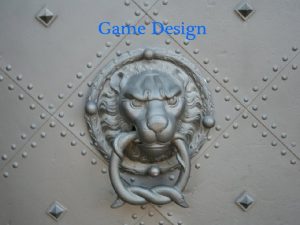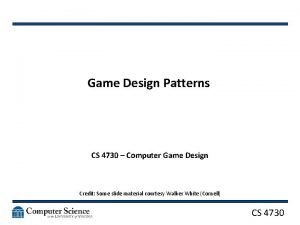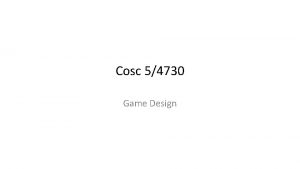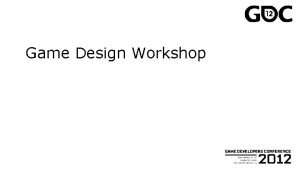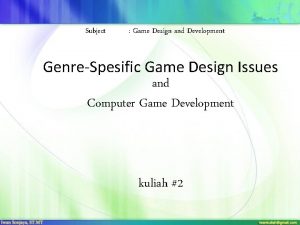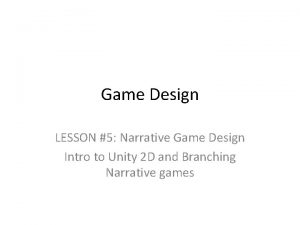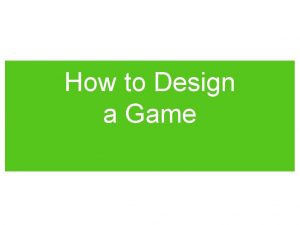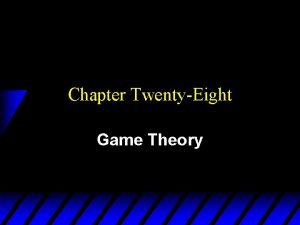Lecture 10 Game Design This lecture helps prepare
































- Slides: 32

Lecture 10 Game Design This lecture helps prepare you for the project by showing how to design games, execute them and retrieve the output from experimental sessions.

Designing games in extensive form 1. Experiments are designed in window 2. Elements of designing an extensive form game are: 1. Drag and drop the elements into the design window. 2. Start with which designates the start of a tree. 3. When you drop into design window it changes color to red to indicate the start of the game.

Basic steps in designing a game tree 1. To draw a tree, drag and drop into the design window. 2. Select icon by clicking on it and drop a player icon into the design window. 3. General rule: select the predecessor and connect it to the successor icon by connecting to the successor node. Drag and drop player into the design window. It automatically connects to icon. Now player is preselected. We know this because appears on the player’s icon.

Adding more icons 1. Select predecessor icon so it looks like 2. Drag and drop a icon into design window. 3. Player nodes connect automatically. Drag and drop it in the design window

Building a tree 1. Select predecessor node. 2. Drag another into the design window. icon and/or

Deleting parts of the tree and rearranging the tree flow 1. Hold down the Ctrl key as you click on each item you want to delete until all are selected and click on. . “Delete? Are you sure? ” appears on the screen. Click “yes” to delete. 2. Select , click on and drag the mouse to. 3. icon now connects to. Icons are connected 1. All the parts of the “tree” that were selected were deleted. 2. Only “Nature” icon is left and it is not connected to the tree.

Adding payoffs 1. Select or and drag and drop icon on the design window. 2. Each payoff node is assigned a number in the ordered created. 3. Only payoff icons are numbered in the design window. Drop payoff on design window. Payoff added and assigned number 1. Payoff added and assigned number 2.

Duplicating parts of the tree 1. Select a part of a tree you want to duplicate. Place your cursor in front of the first node. Click and hold while you drag your cursor to select the nodes you want or just hold down Ctrl as you click each item you want to duplicate. 2. Click on (duplicate). 3. Select the predecessor node, click on and drag the mouse to the desired node to connect the duplicate to the tree. Duplicate is created but not connected to the tree. Duplicate is connected to the tree.

Editing , and 1. To change a name, double click on the icon and rename it. 2. When name of a player is changed, it is added to the payoff icon. Note: does not have payoffs. 3. To place a text in a new line, separate text with “” (i. e. 4. appears as: ).

Creating/ removing information sets 1. Recommended to add information set before labeling choices. The choice’s text is automatically copied to the choice corresponding to the node in the same information set. 2. To add an information set, select a node, click on and drag the mouse to the next node. 3. To remove the info set, click on it to select it and delete it. Click on dotted line to select it. Then delete it. Adding Information set Dotted line disappeared.

Labeling choices 1. Double click on a choice and write a label. 2. When a dotted line connects two player nodes, the same text appears in the corresponding choice. 3. If dotted line is not drawn, the text has to be repeated. 4. You can copy a text from any document and paste it into a choice. Both choices are labeled automatically with dotted line. All player’s choices are labeled.

Editing chance probabilities in 1. Only whole numbers or decimal numbers can be written as weights. 2. When the weights are accompanied with labels there must be at least one empty space between the number and the label, just like: 0. 4 and 0. 6 represent the weights and because it sums up to 1 it means that there is 0. 4 chance that left node will be selected and 0. 6 chance that the right node will be selected. 2 and 8 represent the weights and it means that there is a 0. 2 chance that left node will be selected and a 0. 8 chance that the right node will be selected.

Editing payoffs 1. Double click on the appropriate payoff and write a number under “Number or formula” and click Accept. 2. Payoffs can be expressed with mathematical formula, drawn from a distribution. Moderator will see the formula and subjects will see actual draws or results of a mathematical operation.

Aligning the tree 1. All the options for tree display are at the bottom left: 2. Align payoffs on the same line by selecting option. 3. Not selecting removes player’s names from the payoffs. 4. Not selecting allows free drawing of a tree. Recommended only to deselect and select to align the tree properly. No player’s names in the payoffs

Review of some basic commands The following commands are listed at the top of a design window: 1. For designing a tree or a matrix use the circled icons. 2. : For deleting selected parts of a tree/icons in the design window. 3. : Reverse to a previous step. Not recommended. Instead select items you want to delete and click on. 4. : To duplicate a selected part of the tree. 5. : Designate a start of a tree. The tree starts with the colored in red. If is grey, click on to change the color to red: 6. : Enlarge or reduce the fonts in the tree.

Saving a tree as a file 1. Click on File and “Save as” to save the file. The program automatically adds suffix “mgd”.

Steps for conducting an experiment 1. Select tab and make sure that the right tree is displayed on the design window. 2. Before conducting an experiment test the game by clicking on to make sure it runs correctly. 3. To run an experiment, click on. 1. The name and the location of the loaded game is also shown at the bottom of the screen. will appear in “client Play” window when you start a session:

Test a game 1. Click on to see all client’s /subject’s windows. 2. Make moves for each subject to test the game. 3. Result window is also shown in the test session. Display of client windows at the start of a test session Display after selecting a move for each player Results of the moves selected.

Retrieving the data after the experiment 1. Click on from the menu and click on. 2. The files have. xml extension, and the name of the file includes the date and time of the experiment and the name of the saved tree.

Viewing the data 1. After selecting a file and opening it, drag and drop either a green icon (i. e. ) or a yellow icon ( ) or both into. Each terminal node in the design window has a number and that number corresponds to the terminal node in the data.

Viewing choice data 1. To only view data on choices in the Viewer, drag and drop to the original position. 2. Drag and drop data on choices ( ) into. 3. To sort the data in , click on the heading of a column. Drag and drop back into the original position. Sort by clicking on session

Viewing terminal node and choice data together Drag and drop both and into the .

Exporting Data as a text file (*. csv) 1. Data you want to export has to be in 2. Click on and save the file. .

Import the data into Excel 1. Open Excel, select “Data” tab and click on “From Text”

Design of a matrix / strategic form game 1. Click on window. 2. If the design window is not empty, click on (new definition). 3. Elements for designing a matrix game are: , and. 4. Drag and drop a , into a design window. 5. Make sure the icons are not selected when you drop a new into a design window. Correct wrong Predecessor when a new design window. was not selected was dropped on the 1. Predecessor was selected before dragging a new player on the design window. 2. Select the choice label to delete the connection.

Renaming and 1. Double click on each icon and rename it first before entering payoffs in the matrix.

Assign player’s roles in 1. Right click on a to open it or select a and click on to edit. 2. To assign a specific to be a row/column player, drag and drop that to any row/column from box. 3. move to a box from box. Drop anywhere to assign a column player role Drop anywhere to assign a row player role.

Adding and deleting row and column strategies 1. To add a row or a column, drag and drop on any row/column you want add. 2. To delete a row or a column, drag and drop to the row/column you want to delete. Repeat a process to delete another row/column. Column “d” and row “a” were deleted.

Labeling and reordering strategies 1. Double click on a strategy and rename it. 2. To reorder a strategy, drag and drop a strategy to the a desired place. Drag column “a” to “Remain silent” to reorder the columns

Editing payoffs 1. By default all payoffs are set to zero. Subjects will see zero payoffs if they are not edited. 2. To change a payoff, write a number or a formula in the payoff cell. 3. To save the content of the matrix, click. Subjects will see -6

Matrix game with more than two players 1. Create players in the design window 2. Drag and drop players on the column/row to assign a column/row role for a player. 3. Make sure to click to save the updates. New players created

Saving a matrix game as a file Click on and save the file. The program automatically adds suffix “mgd”.
 Example of douche powder
Example of douche powder Game design lecture
Game design lecture A formal approach to game design and game research
A formal approach to game design and game research Principle of repetition
Principle of repetition 01:640:244 lecture notes - lecture 15: plat, idah, farad
01:640:244 lecture notes - lecture 15: plat, idah, farad Abcdefg game
Abcdefg game Hogs beans
Hogs beans Game lab game theory
Game lab game theory Liar game game theory
Liar game game theory Liar game game theory
Liar game game theory It help us understand people and societies
It help us understand people and societies The spatial strategy of organizing your speech
The spatial strategy of organizing your speech Fatty casing that helps speed neurotransmission
Fatty casing that helps speed neurotransmission Mcdp-1 states that trust
Mcdp-1 states that trust Hibernation is an adaptation that helps animals to _______.
Hibernation is an adaptation that helps animals to _______. How can churches help the community
How can churches help the community What is homeostasis
What is homeostasis What helps maintain the eyeball's spherical shape
What helps maintain the eyeball's spherical shape The federal court system chapter 11 answer key
The federal court system chapter 11 answer key Whats the health triangle
Whats the health triangle Modes of motion is size separation
Modes of motion is size separation ___________ helps in managing lifecycles on cluster node.
___________ helps in managing lifecycles on cluster node. Uts library referencing
Uts library referencing Sabre helps its clients through dashboards and analytics
Sabre helps its clients through dashboards and analytics How tough is the cornea
How tough is the cornea Once upon a time there lived three little pigs
Once upon a time there lived three little pigs Once upon a time there lived three little pigs
Once upon a time there lived three little pigs Which of the following adaptations helps birds fly?
Which of the following adaptations helps birds fly? A balanced health triangle helps to maintain
A balanced health triangle helps to maintain Scanner based research
Scanner based research 15g + 20h distributive property
15g + 20h distributive property Previewing helps the audience mentally organize a speech.
Previewing helps the audience mentally organize a speech. Heavy duty cutting of fabric one handle larger than other
Heavy duty cutting of fabric one handle larger than other


